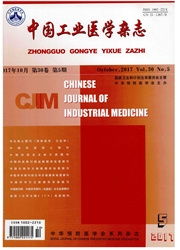

 中文摘要:
中文摘要:
目的 探讨血小板源性生长因子(PDGF)和Ⅲ型前胶原氨基末端肽(PⅢNP)在尘肺病发生、发展中的意义。方法 采用双抗体夹心法,测定77例尘肺病患者(包括32例矽肺、45例煤工尘肺)和77例健康对照者血清PDGF和PⅢNP的表达水平。结果 尘肺病患者血清PDGF和PⅢNP含量分别为(36.31±3.31)ng/ml、(12.59±2.24)ng/ml,对照组则分别为(23.99±2.14)ng/ml、(9.33±2.63)ng/ml,差异均有统计学意义(P〈0.05);矽肺患者血清PDGF和PⅢNP含量均高于煤工尘肺患者,差异有统计学意义(P〈0.05);尘肺血清PDGF和PⅢNP呈线性关系且含量随着期别的增加而降低,差异有统计学意义(P〈0.05)。结论 尘肺病患者血清PDGF和PⅢNP含量可能与尘肺病的发生、发展有关,能否作为尘肺病血清生物标志物有待进一步探讨。
 英文摘要:
英文摘要:
Objective To explore the significance of platelet-derived growth factor (PDGF) and precoUagen III N-terminal peptide (PⅢ NP) in occurrence and development of pneumoniosis. Method The serum levels of PDGF and PⅢ NP in 77 patients with pneumoconiosis (32 silicosis and 45 coal worker's pneumoconiosis ) and 77 healthy persons were detected by enzyme linked immunoserbent assay (ELISA). Result The serum levels of PDGF and Pill NP in pnemoconiosis patients were (36.31 ± 3.31 ) ng/ml and ( 12.59 ± 2.24) ng/ml , while those in controls were (23.99 ± 2.14) ng/ml and (9.33 ± 2.63) ng/ml respectively, there were definite statis- tical significance between the two groups ( P 〈 0.05), and these levels in silicosis patients were higher than that in coal worker's pneu- moconiosis patients ( P 〈 0.05 ). Additionally, the serum levels of PDGF and P Ⅲ NP in pneumoconiosis patients showed linearly decrease with the progress of pneumoconiosis stage ( P 〈 0.05). Conclusion Serum levels of PDGF and Pill NP might be related to the occurrence and development of pneumoconiosis, further study is needed to identify whether they could be a reliable serum biomarker of pneumoconiosis
 同期刊论文项目
同期刊论文项目
 同项目期刊论文
同项目期刊论文
 期刊信息
期刊信息
